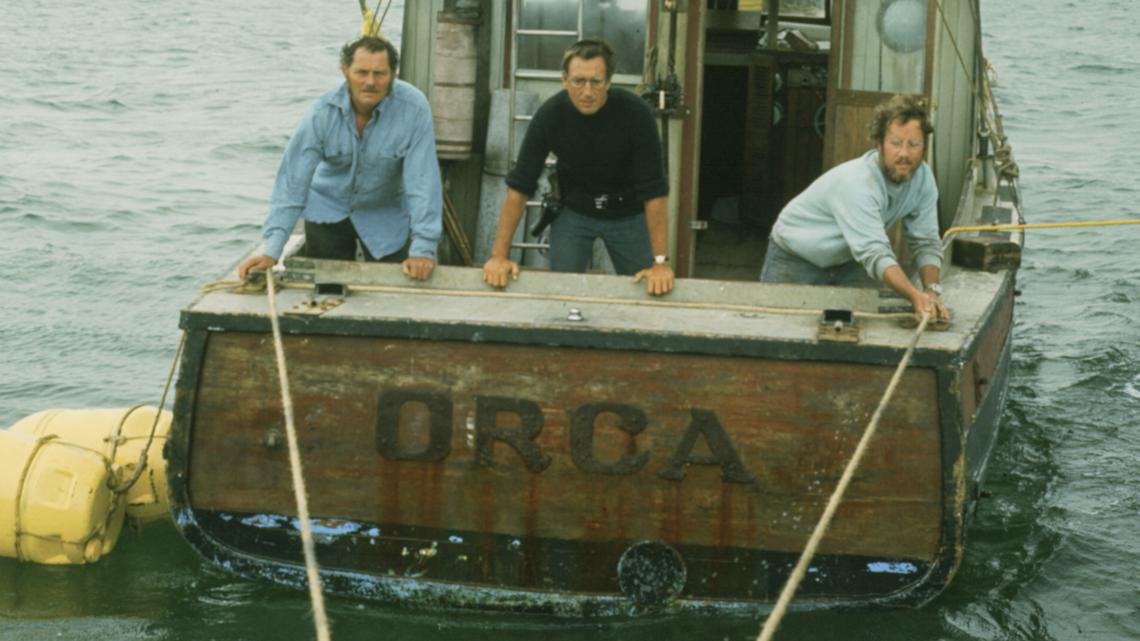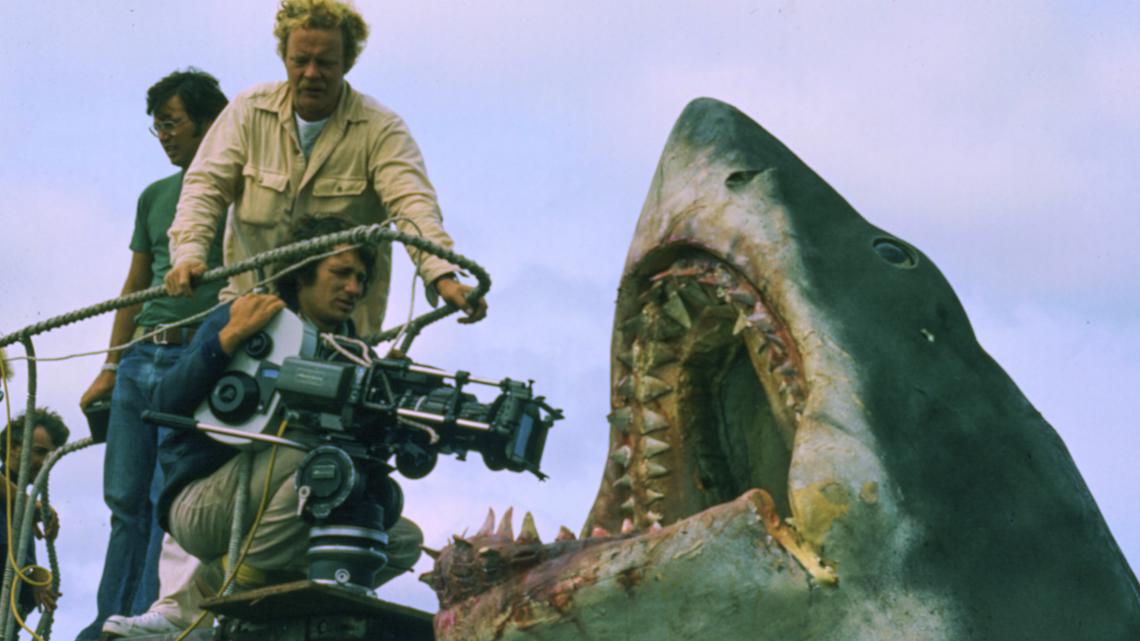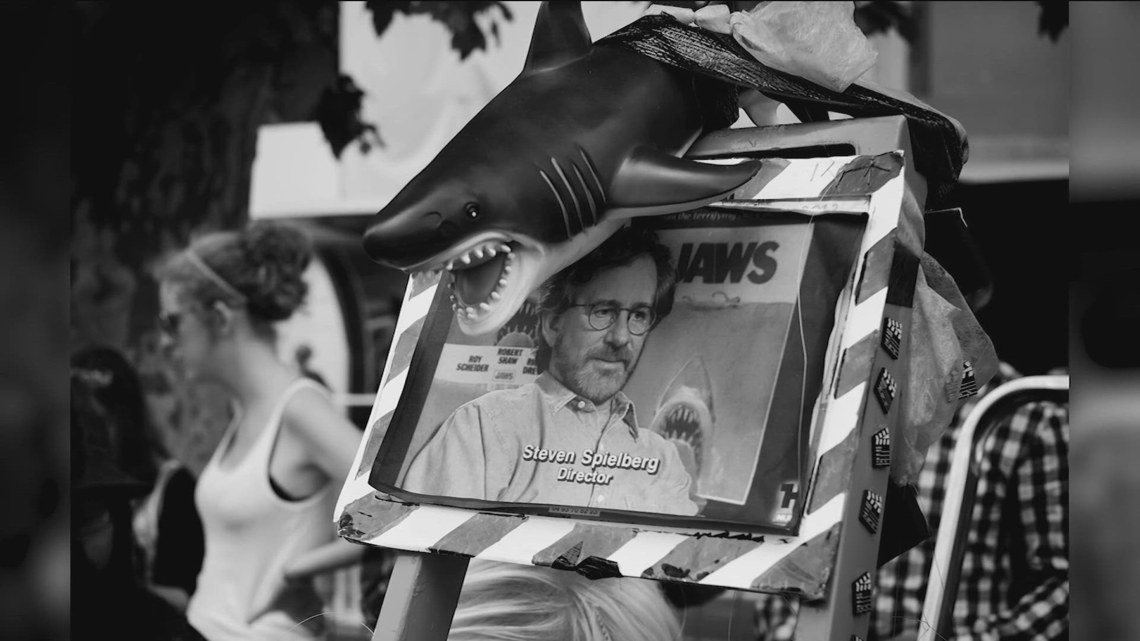The Medallion Theatre at 125 Medallion Center, Dallas, was chosen to be the site of the first public screening of “Jaws.”
DALLAS — Friday, June 20, marks 50 years to the day that “Jaws” was released in theaters nationwide. Audiences across America all of a sudden had simultaneous shark fever and shark phobia. What Alfred Hitchcock did for showers 15 years earlier with ‘Psycho,’ Steven Spielberg did for entire oceans.
Cinematically speaking, “Jaws” changed the course of both moviegoing and moviemaking—the kind of stuff Hollywood dreams are made of for filmmakers and cinephiles alike. And yet, far from the lights of Tinseltown, it was one screening at one theater right here at home in Dallas that charted that course for what is regarded as “the original summer blockbuster.”
As legend has it, for one reason or another,* The Medallion Theatre at 125 Medallion Center, Dallas, was chosen to be the site of the screening—the very first theater to ever show “Jaws” for a public audience on March 26, 1975, two months and three weeks before its official release.
Mind you, not even the title of the film was publicly promoted for what would be a test screening of the rough cut of the movie, meant to see how it played with a crowd of unsuspecting moviegoers unaware of what they were going to see—or that what they were about to see would forever change both the way we went in a theater and went in the water.


The mysterious newspaper ad promoting the screening in The Dallas Morning News, featuring artist Roger Kastel’s now-iconic poster of the shark below and the swimmer above, yet sans title, read:
**“TONIGHT 8:30 P.M.
MAJOR PREVIEW
FIRST TIME ANYWHERE!
The Nation’s No. 1 Best-Selling Book now the screen’s SuperThriller
NO CHILDREN TICKETS SOLD”**
The preview screening was preceded by a 5:30 p.m. showing of “The Towering Inferno,” starring Paul Newman & Steve McQueen (funny enough, both leading men were supposedly “Jaws” author Peter Benchley’s fan casting for starring in the big screen adaptation of his novel).
Stereoscopic cinema preservation pioneer and General Cinema projectionist Paul Adair was in the audience that night. Though Adair passed away in 2019, Texas-based film publicist and Adair’s friend, Kelly Kitchens, remembers him regaling her with stories from the screening—he happened to be at the Medallion watching another movie when an usher announced to the audience that they were going to have a special showing of a secret screening afterwards. The crowd didn’t know what to expect because they didn’t even announce the title—supposedly, the film was still under a working title at that time (though it’s hard to imagine it was ever going to be called anything but just “Jaws”). So Adair stuck around to see what it was… talk about being in the right place at the right time.


The Medallion was a perfect place for something of a spectacle like that. Imagine, if you will: a sprawling single screen, which was in fact crowned the largest indoor screen in Dallas at that time. An awe-inspiring auditorium, fitting of the “everything’s bigger in Texas” reputation. Hundreds of seats, which I imagine not a one was without a butt in it that night. Velvet curtains on the wall—the works. Even a smoking section on the left side of the theater (hey, it was the ‘70s, after all).
A shaggy-haired, 29-year-old then-fairly-unknown filmmaker named Steven Spielberg was also in attendance, for what would be the first true “test of the waters” for his first major movie following his feature film debut—1974’s Texas-set, Texas-shot crime caper “The Sugarland Express.” Spielberg was reportedly standing at the back of the theater, sweaty-palmed and pacing in the aisles over the anxious anticipation of how the movie that could make or break his career would play. It was also, of course, an infamously, notoriously hellish shoot, as the lore goes—its biggest star (the shark, “Bruce,” sarcastically named after Spielberg’s lawyer), a diving diva that always sank and never swam.
Yet little did anyone in the audience know, the film they were about to see, and its filmmaker standing before them—or rather behind them—were both about to change cinema forever.
I love to imagine that moment when the theater went dark, the screen lit up, and those first few notes of John Williams’ simple, yet sonorous and sinister score “dun, dun’d.” It’s the kind of singular cinematic event that film fans and film historians alike wish they had one of those DeLorean time machines to travel back to. I mean, can you imagine being the first audience to see “Jaws” before anyone knew it was, well, “Jaws”?!
Dallas-born writer and author Kurt Eichenwald was also among the lucky ones there that night, recounting on a Cinema Tour group post about the screening: “My cousin Kenny took me. I was 14. And the movie had not had its most horrific scene edited out yet. When it showed, someone threw up, and a lot of people left. The scene really ruined the movie, and since Spielberg was there, I assume he saw the reaction. We were all given cards to fill out after the movie to say what we thought. Both Kenny and I wrote that the one scene ruined the movie.”
In his 2023 book Spielberg: The First Ten Years, author & documentary filmmaker Laurent Bouzereau chronicled the fateful film screening with the director himself, who corroborated the blowing of chunks—er, chum…
“At one point, I remember I was standing at the door, and after the death of the Kintner boy, a man got up and started walking out—I thought, Oh my God. Our first walkout. Then he began running and I went, Oh, no, he’s not walking out—he’s running out. I could tell he was headed for the bathrooms, but he didn’t make it and vomited all over the floor. And I just went, ‘Oh my God, what have I done? What kind of a movie have I made? A man has just barfed because of my film. But the great news was, about five minutes later, he went right back to his seat.”*
And that’s the moment Spielberg said he knew he had a hit.


During the famous scene aboard the Orca where you get your first good glance at the shark, when Roy Scheider’s Chief Brody snips to Robert Shaw’s Captain Quint, “Come on down and chum some of this s—,” and the gargantuan Great White emerges its monstrous head out of the water, Spielberg said at the screening the line “instantly got a nervous laughter, and when the shark burst out of the water, it turned into a scream! Popcorn went flying and it was amazing. It was my proudest moment at the whole preview.”
It makes you wonder if that first audience was even able to hear, in that moment, over the commotion, what has become the film’s most famous line that immediately follows? (For the record, it’s “you’re gonna need a bigger boat,” and not “we’re gonna need a bigger boat.”)
The director recollected overall: “It was very, very loud and people went crazy. This preview was the most extraordinary response I could ever have imagined.” He further remarked that “the numbers were the highest in Universal’s history, the executives were happy, the audience loved the movie, we were all happy.”
Michael Schulman’s Oscar Wars: A History of Hollywood in Gold, Sweat, and Tears tells the tale of the filmmaker and producers’ post-screening celebration at the Registry Hotel on Mockingbird Lane, toasting champagne until 4 a.m.
So much a hit, in fact, that from henceforth Spielberg considered the Medallion his good luck charm—or maybe more appropriately, his lucky medallion. When Spielberg set his sights next from the seas to space, he brought his highly anticipated sci-fi follow-up, “Close Encounters Of The Third Kind,” back to the test screen at the same theater two years later in 1977.
Another successful test screening at his “good luck theater,” as he’s referred to it in interviews over the years. However, Spielberg’s luck soon ran out in 1979 with his WWII comedy “1941,” which broke the director’s lucky streak at the Medallion.
“I took ‘1941’ there, and you could hear a pin drop three-quarters of the movie,” Spielberg told the audience at the 2022 TCM Classic Film Festival in a conversation with Ben Mankiewicz.
So Spielberg then went right down the road to join his friends like George Lucas at the nearby NorthPark I & II—a legendary theater with lots of lore in its own right. But like Rick and Ilsa will always have Paris, Steve and Bruce will always have the Medallion.
And when “Jaws” officially opened on June 20, 1975, freshly fine-tuned from the Dallas screening and another in Long Beach after, it seemed some of the magic from the Medallion had rubbed off on the movie. It not only became the highest-grossing film of that year, but also the first movie to break $100 million at the box office ever (displacing “The Godfather” as the highest-grossing film up to that point). A “super-blockbuster,” as Variety called it.
The world of movies was now pre-“Jaws” and post-“Jaws”, and the summer movie season as we know it had dawned. Or, if you will, “it’s a beautiful day, the beaches are open, and people are having a wonderful time.” Spielberg was now the mayor of “Shark City,” as Brody quips. The rest is, well, as they say, history.
As for the Medallion itself—well, it bounced around from owner to owner over the years: seven in total in its 32-year run. It was converted from one screen to three screens in the ’80s and eventually five screens in the ’90s. At one point, it shared a parking lot and the Medallion Shopping Center—quite coincidentally—with another famous piece of movie distribution real estate: the very first Blockbuster ever, which opened in October of 1985! The irony, considering “Jaws” basically invented the blockbuster.
It went from first-run films to second-run (aka a bargain dollar theater), then to art house, classics, and midnight movies. In its final years, it became an “outlet for low-budget, locally produced films” and “promotional showmanship (including live hypnotists, clowns, and other gimmicks),” according to Cinema Treasures.
But as the newly minted megaplexes moved into Big D, it was tough for the little Medallion—with its alternative programming, film projection, and its five screens—to keep up with the times and the emerging digital technology in theaters. It closed its doors for good on December 13, 2001. One of its final films before the screens went dark? The one that first lit them up on October 30, 1969—”Butch Cassidy And The Sundance Kid.” It then sat vacant for four years before it was finally demolished in May 2005 to make way for an anchor store for the shopping center.
These days, a Kohl’s department store stands in its place, where cinema has been replaced with sensible slacks. Hey, you might even find a “Jaws” t-shirt in there. You’re gonna need a bigger cart. And for the record, the Blockbuster is now an Applebee’s / Mattress Firm.
But the memory of the Medallion lives on—like a movie that plays in our brains. For me, as a kid who grew up in Dallas in the Amblin era of the ’80s and ’90s, obviously obsessed with Spielberg, this local legend of “Jaws” and the Medallion Theatre has always offered some kind of special cinematic connection to a movie and moviemaker that has meant so much to me, in both my personal and professional life. Not thousands of miles away in the glitz and glamour of Hollywood or in the far-off fictitious beach town of Amity, but right here in our own backyard. That is, after all, the power of the shared experience of the cinema—what happens every time when we all sit down in that dark room together, the projector lights up the screen, and magic happens. The magic of the movies and the movie theaters that show them.
So next time you’re driving through the parking lot of Medallion Center on your way to Target, take an extra moment to look around and appreciate the cinematic history that once occurred on those hallowed grounds—and pour one out for the old movie house at Skillman and Northwest Highway. I’ll drink to your leg, Medallion Theatre. And cheers to 50 years, Bruce.
P.S.: “Jaws” returns to theaters this summer to mark the occasion of the 50th anniversary, so while you might not be able to watch it at the Medallion, you can still relive the movie magic and see it on the big screen as it was meant to be seen!
A film projectionist would tell you that it was the Medallion’s capability to show films with “unmarried opticals,” or visual effects or titles that did not yet have sound added to them, given this was a rough cut and the film was unfinished. A film producer would tell you it was for the mixed demographics of a major media market in a Middle America metropolitan city like Dallas. They’d probably both be right.
For all you movie nerds who geek out on this kind of movie minutiae…for context, in the original cut of the film, the scene where the young Alex Kintner is attacked by the shark was far more gory & gruesome, yet in the true fashion of the film, ultimately Spielberg and editor Verna Fields decided showing less was more effective. It can be assumed that this test screening was one of the events that led to those creative cuts. There’s an additional story about how Spielberg went back and reshot & reworked Ben Gardner’s severed head, spending $3,000 of his own money to finely tune it to get it just right. Money well spent, I’d say, as it is still to this day one of the greatest jump scares committed to celluloid.
Paul Adair had also noted that in the rough cut they showed, there was a full shot of the shark earlier in the film that was removed in the final cut based on feedback from the test screening, saving the grand reveal of the shark to maximize the impact for the film’s climax.
